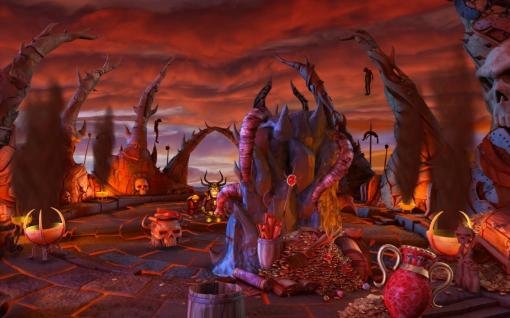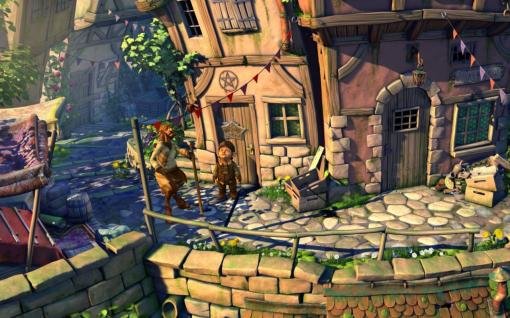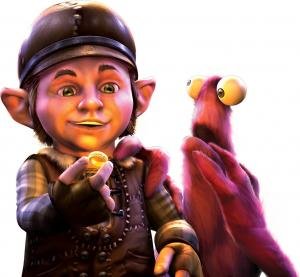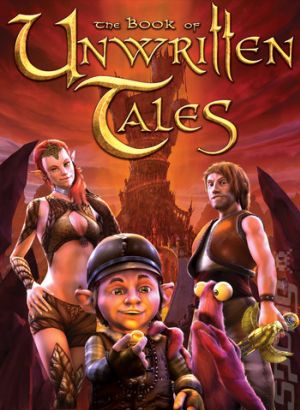The Book of Unwritten Tales hands-on archived preview

Much of the ink spilled about The Book of Unwritten Tales so far has been about its on-again/off-again odyssey towards an English-language release. With deadlines being passed unfulfilled, publishers going bankrupt, and just general pandemonium wherever this game was concerned (or maybe it only felt like that), the fantasy adventure that was so highly acclaimed in Germany seemed destined to remain out of reach for the rest of us. That all changed recently when developer KING Art Games re-acquired the rights to its own game from publishing limbo, proudly proclaiming a localized international release was on the horizon. And guess what? They weren’t kidding, because I just played through two of the game’s substantial five chapters in an early preview version. I’m sure the issue everyone wants answered right away is whether the game is deserving of all the anticipation after such a long delay. Pfft. What a question! Are Critters purple?!
The Book of Unwritten Tales is something of a pastiche of other fantasy works that have come before it. But it’s not a spoof or a rip-off by any means – it’s more an homage with a nudge-wink sensibility that’s playfully aware of its inspirations, yet fully capable of building a significant new adventure with a personality all its own. Its premise and themes may seem familiar, its characters instantly recognizable, and its locales eerily similar to fantasy worlds you’ve come to know already, but it’s all packaged up in a beautiful way, filled with charm and whimsy in an adventure that ultimately manages to feel completely original. Oh, and it’s a pretty darn fun game while it’s at it.

That’s high praise, but it’s not empty hype. The story itself won’t blow you away, but it should certainly – ahem – ring true for many players. An elderly gremlin named Mortimer MacGuffin knows of a legendary Artefact of Divine Fate, and he fears that the evil Shadow Army will use it to control the world if they find it first. Sure enough, a pair of goons appear to snatch him away, but the old archeologist manages to deliver two vital clues to its location into unlikely hands. He charges Ivo the elven princess with unlocking the secrets of his home to access a hidden book, while little Wilbur the gnome is entrusted with a golden ring (hmmm!) to hand over to the Arch-Mage personally. There are two other central characters in BOUT and plenty of cooperative gameplay, but I only just met the human airship pilot/professional treasure hunter Nate and his little purple Critter pal at the end of my lengthy play time. Most of my journey was spent controlling Ivo and Wilbur alone, as each performed their assigned duties for the “Alliance”.
The first two chapters don’t include a lot of thigh-slapping hilarity, in part because of its early chosen protagonists. Wilbur is a personable but timid little gnome and something of an outcast, even in his own family. Born into a family of mechanical whizzes, Wilbur is far more interested in magic, and passes off any unexplained scientific phenomena as such (though so do I, so that’s not saying much). He works at a dwarven brewery, where business is slow but the boss is still demanding, while his elderly grandfather tinkers on technical experiments at home. Much like The Lord of the Rings’ Frodo, minus the furry toes, Wilbur is no hero by nature, but he has a good heart and a willingness to takes risks for what is right. His naïve innocence shines through his observations of the world, which stand in rather stark contrast to Princess Ivo. The ageless, scantily-clad wood elf is as tall and slender as Wilbur is short and stocky, and her years of life experiences have given her a sharpened, almost cynical worldview. Nate, on the other hand, appears poised to be the game’s driving comic force, with an edgy, in-your-face personality that is sure to lead to plenty of spirited banter.
There is still plenty to amuse and entertain in the opening chapters, though it’s more subtle and often revolves around fantasy tropes and clever pop culture references. Beyond Tolkien’s obvious influence, I already caught numerous riffs on The Chronicles of Narnia, Harry Potter, and even Psycho and Star Wars. Wilbur must find a rare Magic the Gathering-style trading card, Ivo hums the familiar Indiana Jones tune as she cracks a whip, and there’s a lengthy segment involving a World of WarCraft-like RPG played on a hulking arcade cabinet as two merchants role-play as tax men. It’s all tongue-in-cheek silliness that works for grins yet is never overplayed, much like the few breaking-the-fourth-wall references to adventure games. The world itself provides a humourous backdrop as well: the RPG server is run by a “hairy demon” monkey, a talking mummy displays the intelligence of someone whose brain really was sucked out of his nose, and a masked, rapier-wielding Zorro-like rat is the scourge of the town marketplace. Good stuff.

We all know that nothing kills a comedy or character piece faster than poor localization, but KING Art has nailed that aspect on all fronts. The translation is excellent, the direction fluid, and the voice acting uniformly solid, with a wide range of accents from Nate’s American to Ivo’s lovely English to Wilbur’s light Welsh lilt. There’s only a passing attempt at real lip syncing, but I did notice that all lines are perfectly attuned to the length of the English readings, which must have been adjusted specifically for the localized version. It’s a very small point, but it represents the attention to detail shown by the developers in getting everything right. The music is also pleasant, offering a mix of tunes from tubas and woodwinds in the snowy, mountainous dwarven bastion to more traditional harp, flute, and accordion fantasy fare in the human town.
Of course, no matter how good BOUT sounds, it’s bound to take a back seat to how it looks. This game is a visual treat, with lush, vibrantly coloured graphics covering a range of diverse scenery as you travel from a transport dragon in flight to a postcard-quality forest cottage to the swamps of Death himself, with noxious green hues and trees gnarled like tortured faces. There isn’t a lot of ambient animation, but enough to give the world some life, whether it's grazing rabbits, the Arch-Mage’s orbiting planetary mobile, or a flying mechanical fish that was sort-of, kind-of invented by Wilbur. Even supporting character models are distinctively designed, like the lumbering troll goon and the feisty female Orc looking to arm wrestle all comers. Several interactions trigger seamlessly integrated in-game cinematics, from a mechanical rat catcher pursuing its prey to a drill-like elevator spiralling down to Wilbur’s basement. No matter where you go or what you try, it’s all delightfully rendered in high resolution widescreen, and you’ll want to stop and admire each new scene you encounter.
You’ll have plenty of chance to do that, as The Book of Unwritten Tales is packed with gameplay. The sheer number and complexity of objectives means that you’ll spend a fair bit of time in each place. This can drag the pace down at times, as it’s hard to feel like you’re making much progress, but it’s a small trade-off for having so much to do. Conversations are lengthy, with variable choices to make on occasion, and there are puzzles coming out the wazoo. Most are inventory-based, and many involve multiple requirements, whether it’s collecting travelling equipment (complete with helmet that would do Guybrush Threepwood proud), proving yourself worthy of a mage diploma, or making explosive beer. A couple involve shrinking Wilbur down even further from his already-diminutive size, which is always good fun. There are a few dialogue puzzles as well, including an interactive mapping sequence and one clever scenario involving a Wheel of Fortune at the travelling fortune teller’s caravan.
The tasks are all nicely spread out, giving you several goals to work on at once while never feeling overwhelming. The interface contributes with its own helpful features, like hotspots disappearing after all relevant interactions (if any) are completed, and the cursor highlighting only those inventory applications that will actually be successful, including combinations with other items, saving you a gazillion “that won’t work” comments. There is no hint feature besides a hotspot highlighter, but although I occasionally hit a few “uh oh, out of ideas” moments, they never lasted long, and were usually resolved by revisiting characters to see if they had anything new to say.
If you think I’m exaggerating about the wealth of gameplay offered here, the game clocked me at a whopping SEVEN hours to get through the first two chapters alone. That’s more than many games offer in their entirety, and here it just felt like scratching the surface. United at long last, this small fellowship of four heroes was finally ready to seek out the fabled treasure itself, having only just completed the preliminaries when I left off. Meanwhile, the unseen but wicked-throated Arch-Witch Mortroga plotted from her Mount Doom-like tower to confront them at every turn. Who will win? That’s still to be discovered when The Book of Unwritten Tales releases some time this fall. Who will be there to find out? Well, if its quality stays consistent to the end, you should be, as this game looks to be one of the more enjoyable fantasy adventures in recent years. Who can tell us more in the meantime? Why, that would be the game’s Creative Director Jan Theysen, who took some time to answer our questions in the interview to come. Read on!
Adventure Gamers: So, for a while there it sure looked like The Book of Unwritten Tales was turning into a regrettably prophetic title outside of Germany. We know what the publishing roller coaster felt like from the outside. What can you tell us about the agonizing process from the inside?
Jan Theysen: It was terrible. Thanks for reminding me!
Okay. Here is the whole story minus some four letter words that kept flying through my head.
We pitched the idea for The Book of Unwritten Tales to several German publishers in 2008. We ended up with a small and pretty new publisher at that time, HMH. BoUT became a big success in Germany and we talked to HMH about future projects inside and outside of the adventure genre. We agreed to make a “sequel” to BoUT called The Critter Chronicles. Unfortunately, HMH declared bankruptcy a few months later and that’s where the problems began. The HMH insolvency administrator blocked every attempt to buy out the rights in order to release BoUT worldwide and to finish The Critter Chronicles. Things turned ugly and we found ourselves in a lawsuit while we were finishing The Critter Chronicles with our own money.
At that point the insolvency administrator made a deal with JoWooD regarding BoUT, The Critter Chronicles and Deck 13’s Haunted. Neither we nor Deck13 were interested in a co-operation with JoWooD because of their bad reputation and their own financial problems. So we declined every co-operation and prepared ourselves to reach an agreement in court. Weeks later, JoWooD declared bankruptcy and all of a sudden the HMH insolvency administrator was interested in our offer to buy back all the rights.
Now we are just happy that finally everything turned out the way it should be and that we can publish The Book of Unwritten Tales worldwide by ourselves.
 AG: Whew! Did it ever seem like the game would be caught in rights limbo and never release internationally?
AG: Whew! Did it ever seem like the game would be caught in rights limbo and never release internationally?
Jan: After the HMH insolvency we honestly thought that the game could be released internationally in a couple of months. We were the co-producers of the game, we owned part of the rights and made a good offer to the insolvency administrator. To this day it makes no sense to me that they didn’t give us the game back then, but put it on hold and later sold it to a company with well-known problems.
I always believed that BoUT would be released worldwide, but I never thought it would take so long.
AG: Well, we're certainly glad you persevered. But even after all those years of anticipation for the game, we really don't know all that much about it. Tell us about BoUT.
Jan: My business partner Marc and I met in elementary school. We loved Monkey Island, Simon the Sorcerer, Discworld and all those classic adventure games. We tried to develop games like that by ourselves when we were kids and kept the dream of making such an adventure game ever since. So The Book of Unwritten Tales was our shot at making a classic adventure game.
In our first pitch document, there was a sentence like: “It’s Monkey Island 2 in an RPG/fantasy world with high res graphics”... and I think that’s exactly what it turned out to be (obviously not as good as MI2 but... you know). Those old games influenced us much more than any adventure games that came out in the last 10 years. When it came to structure, humor, puzzle design, character development and things like that, we always asked ourselves: What would Ron (Gilbert) do?
So in some ways BoUT is a very old school game. But at the same time we tried hard to give it a fresh look and make use of up-to-date technology.
BoUT has been released in Germany, Austria and Switzerland and it actually wasn’t a huge hit regarding sales figures in the beginning. But we had excellent word-of-mouth advertising and it became sort of a “sleeper hit”. No other new adventure since the old LucasArts days received higher ratings from the press and players alike. And the most common feedback from fans is that BoUT has a good “flow”. You can enjoy playing the game without major frustrations. And that is something we really strived to achieve. Every time you have to look at a walkthrough or are angry about an illogical puzzle it drags you out of the story, the atmosphere and the world.
So if you like to lose yourself in a fantasy world and play with a smile on your face instead of wrinkles on your forehead, BoUT is the right game for you.
AG: The four main characters each have unique characteristics and abilities. What can you tell us about… say, what a gnome has on a Critter, or an elf princess over a human?
Jan: The four characters are all very different from each other. They see the world very differently and have their own kind of humor.

Wilbur the gnome is a really loveable character. He is the youngest of our heroes. He has never left the mountains before, he is very kind and naive. He walks through the world with his eyes wide open in astonishment. For him, Nate and Ivo are probably the coolest people he’s ever met. But over the course of the story, it’s actually Wilbur that takes more and more responsibility and becomes a driving force.
Ivo, the elf-princess, is the only competent character in the game. She is an experienced adventurer and usually the one who has to rescue “the boys” as soon as they get into trouble again. She is a little bit arrogant but then again... she is a hot elf chick, so that’s okay.
In Ivo’s eyes, Nate, self-proclaimed air-ship captain and treasure hunter, is... well... a human man. He is crude and he doesn’t know when to shut up. Diplomacy isn’t his strongest suit. The critter is his strange, furry companion and best (and only) friend.
AG: Does the game involve much actual cooperative gameplay between the characters, or is it more a matter of using each protagonist at the prescribed time to advance the story?
Jan: There are periods where you can only play as one character. For example, at the beginning of the story Wilbur and Ivo are introduced and you learn how both of them are dragged into the plot. Later on there are periods where you have to play with two or even three characters at the same time to solve puzzles and there are periods where you can choose with which of our characters you would like to continue.
AG: This is your first full-fledged adventure game as a company, but you’re no strangers to the genre. What’s KING Art’s origin story?
Jan: As mentioned before, we always wanted to make an adventure game. Even while we were making browser games and stuff like that, we still thought about adventures. Our first opportunity to do something in this genre was a small scripting job on Simon the Sorcerer IV.
Then in 2008, dtp asked us if we were interested in taking over the development of Black Mirror 2. Oh yes, we were! We developed parts of the story, the puzzles and dialogues and started developing our kAPE prototype system. kAPE, which is still in use today, enables us to do quick prototypes of adventure games. dtp ultimately decided to give the project to an in-house development studio to finish, so we were free to start working on The Book of Unwritten Tales.
AG: Given the nature of the story, can I assume you’re longtime fantasy and RPG fans as well? Any games or other media stand out for you as being particularly influential?
 Jan: We have a couple of huge fantasy and RPG geeks here at KING Art! I think there hasn’t been a single western RPG game in the last 20 years that hasn’t been played to bits in the company (be it PC game, board game or pen & paper). And yes, it helps to have read Harry Potter and Discworld if you want to have a job here and yes, I just bought The Lord of the Rings special extended blu-ray edition and don’t care that I already own the DVD special extended edition… and the regular edition… and also the single movie DVDs. I just love this stuff, okay?!
Jan: We have a couple of huge fantasy and RPG geeks here at KING Art! I think there hasn’t been a single western RPG game in the last 20 years that hasn’t been played to bits in the company (be it PC game, board game or pen & paper). And yes, it helps to have read Harry Potter and Discworld if you want to have a job here and yes, I just bought The Lord of the Rings special extended blu-ray edition and don’t care that I already own the DVD special extended edition… and the regular edition… and also the single movie DVDs. I just love this stuff, okay?!
But probably the biggest influence from the fantasy realm was World of Warcraft. At the time we wrote BoUT, we had a pretty serious WoW-addiction problem in our company. So when you look at some of our designs, you might find interesting similarities. Even a couple of the staff’s WoW character names appear in the game.
AG: Why go for comedy instead of a straight-up fantasy tale?
Jan: Ron did it before, so it must be right.
AG: Can’t argue with that logic. So currently you’re working on The Critter Chronicles, which is a prequel to The Book of Unwritten Tales, correct?
Jan: That’s right. The Critter Chronicles were conceived as a “standalone add-on” to BoUT. But since we had much more time to develop the game than we expected, it became bigger and bigger. It still is “only” 10-12 hours long, so we don’t call it “BoUT 2”, but it definitely became a bigger project than we originally planned.
The good thing is that we kept the international rights for The Critter Chronicles so it won’t take two years to release the game worldwide!
AG: Will that be the end of BoUT, or are there more stories you’re eager to tell in that universe after that?
Jan: We have some pretty cool ideas for the setting and the story of a possible “BoUT 2”. But at the moment it is not in development. Our next adventure after The Critter Chronicles will most likely be a mixture between a “whodunit” and a heist-story, taking place in the ‘60s.
AG: Finally, top secret question that I promise not to tell anyone (besides the thousands of people reading this): What’s Critter’s real name? (Come on, we know you call him something around the office!)
Jan: Let’s see... In the office we call him “Vieh”, which means... “Critter” in German.
I had to check in our “Critter database”. Whenever the critter refers to itself in one of the games it says: “Criv-cutuss. Kulala-bo!” That might be its name. Or it means “Critter” in his language. Nate calls it “Critter” and he knows the little guy the longest so maybe we should just leave it that way.
AG: Well hey, call him whatever you like. I just have two words to say in closing: Critter plushies! What, you thought I was going to say thank you? Well, that too! We really appreciate you taking time to answer these questions, and can’t wait to see what all the hype is about when The Book of Unwritten Tales finally arrives.













